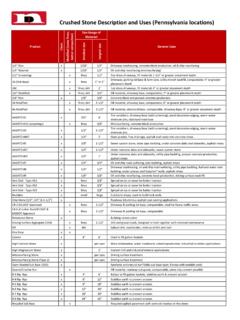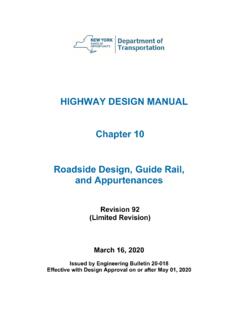Transcription of Guide for Design and Construction of Concrete Parking Lots
1 ACI 330R-01 supersedes ACI 330R-92 (reapproved 1997) and became effectiveOctober 1, 2001, American Concrete rights reserved including rights of reproduction and use in any form or by anymeans, including the making of copies by any photo process, or by electronic ormechanical device, printed, written, or oral, or recording for sound or visual reproduc-tion or for use in any knowledge or retrieval system or device, unless permission inwriting is obtained from the copyright Committee Reports, Guides, Standard Practices,and Commentaries are intended for guidance in planning,designing, executing, and inspecting Construction . Thisdocument is intended for the use of individuals who arecompetent to evaluate the significance and limitations of itscontent and recommendations and who will accept respon-sibility for the application of the material it contains.
2 TheAmerican Concrete Institute disclaims any and all respon-sibility for the stated principles. The Institute shall not beliable for any loss or damage arising to this document shall not be made in contractdocuments. If items found in this document are desired bythe Architect/Engineer to be a part of the contract docu-ments, they shall be restated in mandatory language forincorporation by the Architect/Engineer. 330R-1 Guide for Design and Construction ofConcrete Parking LotsACI 330R-01 Concrete Parking lots serve many transportation facilities, industrial plants,commercial developments, and multifamily housing projects. They are usedfor storing vehicles and goods, and provide maneuvering areas and accessfor delivery vehicles. The Design and Construction of Concrete slabs forparking lots and outside storage areas share many similarities with thedesign and Construction of streets and highways, but they also have somevery distinct differences.
3 A full appreciation of the differences and the modi-fication of Design and Construction procedures to take these differences intoaccount can result in economical Concrete Parking lots that will provide sat-isfactory service for many years with minimum maintenance. This Guide includes information on site investigation, thickness deter-mination, Design of joints and other details, paving operations, and qual-ity-assurance procedures during Construction . Maintenance and repair arealso : air entrainment; coatings; compacting; Concrete Construction ; Concrete durability; Concrete pavements; Concrete slabs; curing; dowels;drainage; economics; finishing; joints; joint sealants; loads (forces); loadtransfer; maintenance; Parking facilities; quality control; reinforcing steels;repairs; resurfacing; soils; specifications; structural Design ; subbases; sub-grades; thickness; tolerances; welded-wire fabric; 1 General, p.
4 Introduction DefinitionsChapter 2 Pavement Design , p. Pavement Traffic Subgrade Concrete Thickness Steel reinforcement in Parking lot Joint filling and Pavement Curbs and islandsChapter 3 Materials, p. Material specificationsReported by ACI Committee 330 William R. HookChairmanKenneth G. KazanisVice ChairmanRussell W. CollinsSecretaryRichard O. AlbrightD. Gene DanielRobert V. LopezJ. H. AllredDale H. DiulusRichard E. MillerWilliam L. ArentEdwin H. GebauerJon I. MullarkyDon A. ClemNader GhafooriDiep TuLawrence W. ColeFrank A. KozeliskiPhil WeissV. Tim CostFrank LennoxThe committee acknowledges the valuable assistance of David G. Pearson in carrying out the finite-element analyses to obtainthe curves to determine stresses in Parking lot COMMITTEE REPORTC hapter 4 Construction , p. Subgrade Layout for Paving Placing, finishing, and Curing and Opening to trafficChapter 5 Inspection and testing, p.
5 Subgrade Concrete Construction operationsChapter 6 Maintenance and repair, p. Surface Joint and crack Full-depth Undersealing and Parking lot cleaningChapter 7 References, p. Referenced standards and Cited referencesAppendix A Procedures for Concrete pavement Design , p. Source of thickness tablesAppendix B Subgrade, p. Soil Problem Expansive Frost Support uniformityAppendix C Suggested joint details, p. Pavement joint detailsAppendix D Parking lot geometrics, p. Parking Entrances and Truck- Parking Additional informationAppendix E SI (metric) tables, p. 330R-31 CHAPTER 1 IntroductionConcrete Parking lots have many similarities to othertypes of Concrete pavement. On the other hand, Parking lotsdiffer from other pavements in that most of the area is in-tended for storage of vehicles and other goods rather thanfor movement of vehicles. The Design of Concrete parkinglots should follow generally accepted procedures for con-crete pavements as outlined in this Guide .
6 Load-bearing ca-pacity, drainage, crack control, life-cycle cost,constructibility, and maintainability are other characteristicsthat are important in the Design and Construction of concretepavements, including Parking Parking lot pavements provide a hard surface forvehicle maneuvering and storage areas. Concrete parkinglots also provide a surface that protects the underlying soiland reduces pressures imposed by Design loadings to a levelthat the subgrade soils can support. Additionally, concreteparking lots, driveways, and access lanes are often constructedto serve specific types of traffic, such as cars and light trucksonly or predominantly heavy delivery vehicles. Typically, Concrete Parking lots do not serve the samebroad spectrum of traffic loading, from light vehicles toheavy trucks, as are highways and arterial streets. Facilitiesdesigned to accommodate both light vehicles and heavier de-livery trucks usually employ traffic controls to separate andchannelize the heavier trucks away from areas designed forautomobiles and light trucks.
7 Facilities designed for heaviervehicles are likely those facilities where relatively accuratepredictions of vehicle sizes and numbers are possible. Facil-ities intended to serve only light vehicles may have concreteparking lot slabs with thicknesses influenced by the practicallimitations of the material and environmental effects ratherthan by the pavement stress created by vehicle loads. Dura-bility-related distress is often the most critical maintenanceconcern for lightly loaded Concrete Parking lot leak fuel and lubricants in Parking lots. Vehicles inparking areas usually travel at low speeds, diminishing theimportance of smoothness tolerances. Parking lots shouldalso be designed to serve Parking lots range in size from small, such as atcorner convenience stores and small multiple housingprojects, to large, such as those for shopping centers and truckterminals.
8 Accordingly, Concrete Parking lots are constructedwith a wide variety of Construction equipment, ranging fromhand tools and vibratory screeds to large highway of the relatively high stiffness of Concrete pave-ments, loads are spread over larger areas of the subgradecompared with asphaltic pavements. As a result, thinner con-crete pavements can be used for the same subgrade benefits of using Concrete to construct parkinglots are: Concrete surfaces resist deformation from maneuveringvehicles; Concrete surfaces drain well on relatively flat slopes; Concrete has relatively simple maintenance requirements; Traffic-lane and Parking -stall markings can be incorpo-rated into the jointing pattern; Concrete is not adversely affected by leaking petroleumproducts; The light-reflective surface of Concrete can be efficientlyilluminated with minimal energy requirements and canhelp reduce summertime surface temperatures.
9 AndGUIDE FOR Design AND Construction OF Concrete Parking LOTS330R-3 Concrete Parking lots reduce the impacts of the urbanheat island effect by providing a cooler urban environ-ment and reducing ozone ScopeThis Guide is based on the current knowledge and practicesfor the Design , Construction , and maintenance of concreteparking lots placed on the ground. It emphasizes the aspectsof Concrete pavement technology that are different from pro-cedures used to Design and construct slab-on-grade such asstreets, highways, and floors. This Guide is not a standard nora specification, and it is not intended to be included by refer-ence in Construction contract documents; ACI can beused for these lots have most loads imposed on interior slabs sur-rounded by other pavement, providing some edge support onall sides. Highway and street pavements carry heavy loadsalong and across free edges and are subjected to greater de-flections and stresses.
10 Streets and pavements are usually de-signed to drain towards an edge where the water can becarried away from the pavement. Parking lots are usually de-signed so some of the water is collected internally and is con-veyed away through underground systems. In urban areaswhere rainfall runoff from large impervious surfaces is reg-ulated, Parking lots often serve as detention basins (not ad-dressed in this Guide ). This means that the pavement shouldstore water for a period of time without incurring any dam-age due to loss of support from a saturated subgrade. Park-ing lots often accommodate appurtenances, such as lightingstandards, drainage structures, traffic islands, and land-scaped planting areas. Provisions for these appurtenancesshould be considered in the Design of the jointing system andthe layout for BackgroundDesign methods for Concrete Parking lot pavements aresomewhat empirical and are based on the methods developedfor the Design of highway pavements (that is, the Portland Ce-ment Association method [Thickness 1984] and the AASHTO Design method [AASHTO 1993]).






